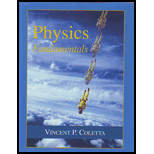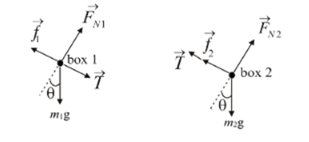
Concept explainers
To evaluate: The acceleration of the two blocks sliding down is to be evaluated.
Answer to Problem 42P
The acceleration of each block is 0.758 m/s2
Explanation of Solution
Introduction:Newton's second law explains that the acceleration of an object is dependent upon two variables. Those are net force acting on the object and the object’s mass.
When the blocks are going down the plane. The frictional force should be upward the plane.
It is known that the component of the gravitational force down the plane is mg cosθ and the
component perpendicular to the plane is mg sin θ as shown in the figure below.

The frictional force acting on the first block is,
Here,
normal force on the first block.
Applying Newton's second law to the first block, the net force along the horizontal direction is
Applying Newton's second law to the first block, the net force along the vertical direction is,
Rewrite the equation for
Substitute
Thus, the tension in the string is,
The frictional force acting on the second block is,
Here,
normal force on the second block.
Applying Newton's second law to the second block, the net force along the horizontal direction is,
Applying Newton's second law to the first block, the net force along the vertical direction is,
Rewrite the equation for FN2.
Substitute
Thus, the tension in the string is,
Compare the equations of tensions, we get
Thus, the magnitude of the common acceleration of the two blocks is as follows.
Substitute 9.8 m/s2 for g, 1.0 for µ1, 1.0 kg for m1, 2.0 kg for m2, 30.0° for θ, and 0.50 for µ2,
Therefore, the acceleration of each block is 0.758 m/s2
Conclusion: By using Newton's second law acceleration can be determined.
Want to see more full solutions like this?
Chapter 5 Solutions
Physics Fundamentals
- The crate shown in Fig. 4-60 lies on a plane tilted at an angle (theta)= 25.0 degrees to the horizontal, with (mu-of-k)= 0.19. (a) Determine the acceleration of the crate as it slides down the plane. (b) If the crate starts from rest 8.15 m up along the plane from its base, what will be the crate’s speed when it reaches the bottom of the incline?arrow_forward(III) (a) Suppose the coefficient of kinetic friction between ma and the plane in Fig. 4-62 is µk = 0.15, and that mA = mB = 2.7 kg. As mB moves down, determine the magnitude of the acceleration of ma and mg, given 0 = 34°. (b) What smallest value of pk will keep the system from accelerating? [Ignore masses of the (frictionless) pulley and the cord.] mB FIGURE 4-62 Problem 67.arrow_forwardWhat is the acceleration of a 11 kg block down a frictionless incline, inclined at theta - 68 degrees.arrow_forward
- calculate the maximum speed that could be maintained when driving DOWN the hill witha constant slope of 3.0 degrees to the horizontalarrow_forwardTwo blocks made of different materials, connected by a thin cord, slide down a plane ramp inclined at an angle 0 to the horizontal, Fig. 4–76 (block B is above block A). The masses of the blocks are ma and mB, and the coefficients of fric- tion are ua and µr. If ma = mß = 5.0 kg, and HA = 0.20 and uR = 0.30, determine (a) the acceleration of the blocks and (b) the tension in the cord, for an angle 0 = 32°. MB FIGURE 4–76 Problem 94.arrow_forwardWhat minimum coefficient of friction is required if thereis a 60.0 km/h speed limit for a flat horizontal curve ofradius 238 m?arrow_forward
- Is it unreasonable to expect a coefficient of friction to exceed unity?arrow_forwardAn object of mass m is sliding with speed vi at some instant across a level tabletop, with which its coefficient of kinetic friction is . It then moves through a distance d and comes to rest. Which of the following equations for the speed vi is reasonable? (a) vi=2mgd (b) vi=2mgd (c) vi=2gd (d) vi=2gd (e) vi=2darrow_forwardBodyA in Fig. 6-33 weighs 102 N, and body B weighs 32 N. The coefficients of friction between A and the incline are us =0.56 and uk=0.25. Angle 0 is 40°. Let the positive direction of an x axis be up the incline. In unit-vector notation, what is the acceleration of A if A is initially (a) at rest, (b) moving up the incline, and (c) moving down the incline Frictionless, massless pulleyarrow_forward
- (III) Two masses ma = 2.0 kg and mg = 5.0 kg are on inclines and are connected together by a string as shown in Fig. 4-61. The coefficient of kinetic friction between each mass and its incline is uk = 0.30. If ma moves up, and mB moves down, determine their acceleration. [Ignore masses of the (frictionless) pulley and the cord.] mB 51° 21° FIGURE 4–61 Problem 65.arrow_forwardA force of 600 N is applied on a block of mass M to pull it at a constant velocity up the incline at an angle of 30degrees with the horizontal. The coefficient of kinetic friction between the surface of the incline and the block is 0.5. Calculate the mass of the block.arrow_forwardA box weighing 1000 N is sitting in an inclined plane with an angle of 45°. Given the coefficient of friction of 0.25, calculate the horizontal force that can start the box the moving forward.arrow_forward
 Principles of Physics: A Calculus-Based TextPhysicsISBN:9781133104261Author:Raymond A. Serway, John W. JewettPublisher:Cengage Learning
Principles of Physics: A Calculus-Based TextPhysicsISBN:9781133104261Author:Raymond A. Serway, John W. JewettPublisher:Cengage Learning
